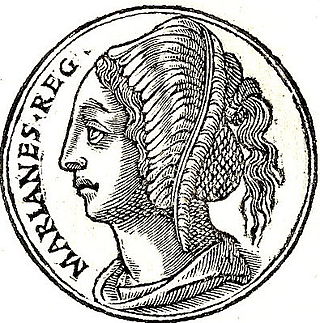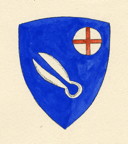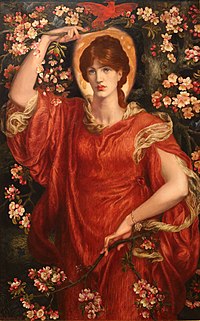
Giovanni Boccaccio was an Italian writer, poet, correspondent of Petrarch, and an important Renaissance humanist. Born in the town of Certaldo, he became so well known as a writer that he was sometimes simply known as "the Certaldese" and one of the most important figures in the European literary panorama of the fourteenth century. Some scholars define him as the greatest European prose writer of his time, a versatile writer who amalgamated different literary trends and genres, making them converge in original works, thanks to a creative activity exercised under the banner of experimentalism.

Lucrezia Borgia was an Italian noblewoman of the House of Borgia who was the daughter of Pope Alexander VI and Vannozza dei Cattanei. She reigned as the Governor of Spoleto, a position usually held by cardinals, in her own right.

This article contains summaries and commentaries of the 100 stories within Giovanni Boccaccio's The Decameron.

The Book of the City of Ladies or Le Livre de la Cité des Dames, is perhaps Christine de Pizan's most famous literary work, and it is her second work of lengthy prose. Pizan uses the vernacular French language to compose the book, but she often uses Latin-style syntax and conventions within her French prose. The book serves as her formal response to Jean de Meun's popular Roman de la Rose. Pizan combats Meun's statements about women by creating an allegorical city of ladies. She defends women by collecting a wide array of famous women throughout history. These women are "housed" in the City of Ladies, which is actually the book. As Pizan builds her city, she uses each famous woman as a building block for not only the walls and houses of the city, but also as building blocks for her thesis. Each woman introduced to the city adds to Pizan's argument towards women as valued participants in society. She also advocates in favour of education for women.

Joanna I, also known as Johanna I, was Queen of Naples, and Countess of Provence and Forcalquier from 1343 to 1382; she was also Princess of Achaea from 1373 to 1381.

The Heptaméron is a collection of 72 short stories written in French by Marguerite de Navarre (1492–1549), published posthumously in 1558. It has the form of a frame narrative and was inspired by The Decameron of Giovanni Boccaccio. It was originally intended to contain one hundred stories covering ten days like The Decameron, but at Marguerite’s death it was completed only as far as the second story of the eighth day.

Artemisia II of Caria was a naval strategist, commander and the sister and the successor of Mausolus, ruler of Caria. Mausolus was a satrap of the Achaemenid Empire, yet enjoyed the status of king or dynast of the Hecatomnid dynasty. After the death of her brother/husband, Artemisia reigned for two years, from 353 to 351 BCE. Her ascension to the throne prompted a revolt in some of the island and coastal cities under her command due to their objection to a female ruler. Her administration was conducted on the same principles as that of her husband; in particular, she supported the oligarchical party on the island of Rhodes.

Fiesole is a town and comune of the Metropolitan City of Florence in the Italian region of Tuscany, on a scenic height above Florence, 5 km northeast of that city. It has structures dating to Etruscan and Roman times.

Italian literature is written in the Italian language, particularly within Italy. It may also refer to literature written by Italians or in other languages spoken in Italy, often languages that are closely related to modern Italian, including regional varieties and vernacular dialects. Italian literature begins in the 12th century, when in different regions of the peninsula the Italian vernacular started to be used in a literary manner. The Ritmo laurenziano is the first extant document of Italian literature.
Love at first sight is a personal experience and a common theme in creative works: a person or character feels an instant, extreme, and ultimately long-lasting romantic attraction for a stranger upon first seeing that stranger. It has been described by poets and critics since the emergence of ancient Greece.

Iaia of Cyzicus, sometimes (incorrectly) called Lala or Lalla, or rendered as Laia or Maia, was a Greek painter born in Cyzicus, Roman Empire, and relatively exceptional for being a woman artist and painting women's portraits. She was alive during the time of Marcus Terentius Varro. In De Mulieribus Claris, his book of women's biographies, Boccaccio refers to her as "Marcia", possibly confusing her with the Vestal Virgin of that name. According to Pliny the Elder: "No one had a quicker hand than she in painting".

"Il Filostrato" is a poem by the Italian writer Giovanni Boccaccio, and the inspiration for Geoffrey Chaucer's Troilus and Criseyde and, through Chaucer, the Shakespeare play Troilus and Cressida. It is itself loosely based on Le Roman de Troie, by 12th-century poet Benoît de Sainte-Maure.

Mariamne I, also called Mariamne the Hasmonean, was a Hasmonean princess and the second wife of Herod the Great. Her parents, Alexandra Maccabeus and Alexander of Judaea, were cousins who both descended from Alexander Jannaeus. She was known for her great beauty, as was her brother Aristobulus III. Herod's fear of his Hasmonean rivals led him to execute all of the prominent members of the family, including Mariamne.
Andrea Acciaioli or Acciaiuoli was an Italian noblewoman, as the Countess of Altavilla in the 14th century. Born in Florence, she was known through her brother to Giovanni Boccaccio, and was the person to whom he dedicated his book On Famous Women.

Maria d'Aquino was a Neapolitan noblewoman who is traditionally identified with Giovanni Boccaccio's beloved and muse Fiammetta.

The Decameron, subtitled Prince Galehaut and sometimes nicknamed l'Umana commedia, is a collection of short stories by the 14th-century Italian author Giovanni Boccaccio (1313–1375). The book is structured as a frame story containing 100 tales told by a group of seven young women and three young men; they shelter in a secluded villa just outside Florence in order to escape the Black Death, which was afflicting the city. Boccaccio probably conceived of the Decameron after the epidemic of 1348, and completed it by 1353. The various tales of love in The Decameron range from the erotic to the tragic. Tales of wit, practical jokes, and life lessons contribute to the mosaic. In addition to its literary value and widespread influence, it provides a document of life at the time. Written in the vernacular of the Florentine language, it is considered a masterpiece of classical early Italian prose.
Il Corbaccio, or "The Crow", is an Italian literary work by Giovanni Boccaccio, traditionally dated c. 1355.
Juan de Flores was a Spanish courtier, knight, administrator, diplomat and author, most known for two "sentimental novels": Grimalte y Gradissa and Grisel y Mirabella, both probably written between 1470 and 1477 and published around 1495. Until recently, little was known of his life. Representative of a class of late medieval "humanist knights", he was associated with the court of García Álvarez de Toledo, 1st Duke of Alba and may have been the nephew of the noble Pedro Alvarez Osorio. In 1476, he was appointed official chronicler to the monarchs Fernando and Isabella; among his other political activities, he may have participated in the civil war of the 1470s and in Grenada. He was "one of the most widely read Spanish authors in Europe", unmatched until Miguel de Cervantes started writing 60 years after de Flores died, and the European popularity of his Grisel y Mirabella was on a par with Diego de San Pedro's Cárcel de amor and Fernando de Rojas's La Celestina.

Nastagio degli Onesti is the protagonist in one of the one hundred short stories contained in The Decameron by Giovanni Boccaccio. The eighth story of the fifth day, it tells of the unrequited love of the nobleman Nastagio for a girl who will eventually be induced to accept Nastagio's affection by the appearance of a rejected lover and her beloved.

Cianghella della Tosa lived in late medieval Florence, Italy. She was born into the Florentine Della Tosa family and married into the Alidosi family of Imola, near Bologna. Most of what is known about Cianghella is due to her reference in Dante's Divine Comedy.
















